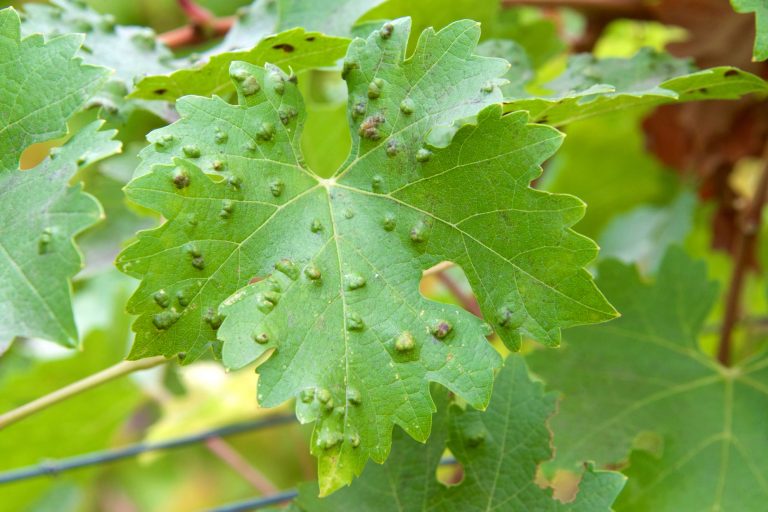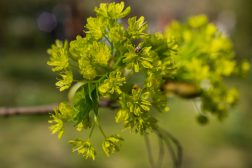Plant Cell Defense

Wart-like leaf galls on grape leaves
Table of Contents
Hydrogen Peroxide
Plants release hydrogen peroxide in response to the presence of a fungal invasion, which attacks by piercing the cell wall of a plant and breaking it down.
This hydrogen peroxide (chemical symbol H202) is a double-edged sword in its defense against the antigen.
One Way: Hydrogen peroxide stops the breakdown of the cell wall
Certain pathogens will use pectinase, a digestive enzyme, to break down the cell wall barrier and invade the plant. The pectinase released by the fungus must be stopped. H202 is involved in halting the action of this pectinase in the following example;
- The H202 is created and moves to the cell wall – the site of the invasion.
- It reacts in contact with an enzyme called peroxidase, which promotes the breakdown of pectinase.
- The foreign chemical is rendered useless.
- The threat of the cell wall being compromised is removed.
Another Way: Some of the H202 triggers the creation of phytoalexins
Phytoalexins are similar to the antiviral proteins previously mentioned as a secondary line of defense. Phytoalexins are a family of hormones that inhibit protein synthesis and thus “shut up shop” in the event of a pathogenic attack by halting the protein production process in our cells.
Chemicals released by the fungus are used to trigger a chemical response in the plasma membrane that makes it aware of the pathogens’ presence.
Hydrogen peroxide from the plasma membrane triggers a chemical response to inform the nucleus of the infected cells of the current situation.
mRNA from the nucleus is transported to ribosomes, as described in the protein synthesis section, where phytoalexins are to be produced (essentially protein synthesis coding for phytoalexins).
The phytoalexins then take on a role similar to that of antiviral proteins, where the presence of a phytoalexin in a cell inhibits protein synthesis and therefore preventing the growth of the foreign agent by removing all possible avenues of invasion for the pathogen, thus eliminating the threat.
Barriers Used by Plants in Defense
Lignin is a strong type of molecule that provides plants with a defensive structure similar to that of fibrous proteins. It acts as a barrier and can be found in wood and is characteristically found in plants that have recently endured pathogen attack.
Callose seals off sieve plates in the plant, effectively shutting off the transport of molecules around the organism. This is done to minimize the chance of the plant transporting infectious material around its own self, and halting the movement of materials that could be used by the pathogen in aid of replicating itself.
Ethylene promotes leaf abscission and is done to sever the plant of dead or dying plant matter. This is done to prevent the spread of infected material, therefore sacrificing infected sections of plant is more economical than taking the risk of the infection spreading.
Galls and tannins are created by the plant to encapsulate foreign agents found within the plant. A gall is an instance where an infected cell becomes inflamed that contains tannins. These tannins play a protective role by segregating the foreign agent and its chemicals from the rest of the plant.
Recommended reading: Maron, L. (2020). Believe your GFP: cytoplasmic RNA granules play a role in plant defence. The Plant Journal, 101(5), 1021–1022. https://doi.org/10.1111/tpj.14738
Read more articles like this here: The Plant Journal – provides a dynamic forum for the ever-growing international plant sciences research community and publishes in all key areas of plant biology.
You will also like...

Neurology of Illusions
Illusions are the perceptions and sensory data obtained from situations in which human error prevents us from seeing the..

Lotic Communities & Animals
A running water environment offers numerous microhabitats for many types of animals. Similar to plants, animals in lotic..

Gibberellins and Gibberellic Acid
This tutorial describes the role of gibberellin family in plants. Find out the effects of gibberellin on plant growth an..

Sleep and Dreams – Neurology
While learning and intelligence are associated with the functions of a conscious mind, sleep and dreams are activities o..

The Homo Species
The evolution of the species of the genus "Homo" led to the emergence of modern humans. Find out more about human evolut..

Genetics – Lesson Outline & Worksheets
Topics Modules Quizzes/Worksheets Description Introduction to Genetics Genetics – Definition: Heredity and ..
